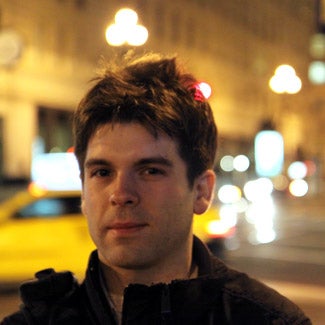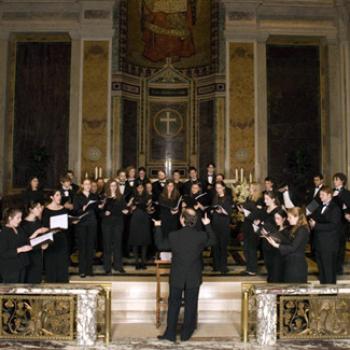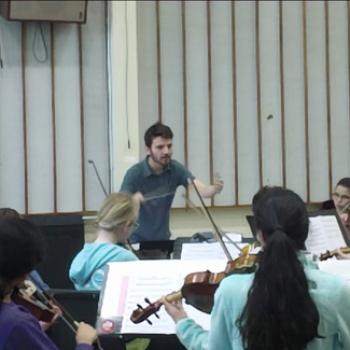On skills learned in the Conservatory
Michael Vito ’04
“In [performance], we must take all of the experience and ability we have attained through our own development and integrate it with that of others... an exercise in fluid, nonhierarchical leadership.”

The Oberlin Conservatory of Music has always had many reasons to be proud. At 145 years, it is the oldest continuously operating music school in the country. Its graduates can be found in major performing institutions across the world. Admission by audition is extremely competitive, and only a small fraction of applicants are admitted each year. Most recently, it was awarded the National Medal of Arts in recognition of its contributions to the oeuvre of American creative expression. Sometimes I have to walk over to the diploma on the wall, just to make sure it was not a dream that I had the privilege to practice in such a place. The training and study I undertook there, both musical and otherwise, have played a large part in shaping who I am today.
When I see the Conservatory mentioned in the news, it is usually in reference to student, graduate, and faculty accomplishments. The most recent headliner, however, has floors, walls, windows, and doors. The Bertram and Judith Kohl Building opened its doors to Oberlin and the world on May 1, 2010. It will serve as a much needed sanctuary for the Conservatory’s jazz department, and will also be a new home for many music theory and history faculty members, as well as the James and Susan Neumann Jazz Collection, the largest private collection of jazz recordings and paraphernalia in the United States.
Perhaps no one is more proud of the Kohl Building than Michael Lynn, Associate Dean for Technology and Facilities, who represented the Conservatory throughout design and construction. Lynn graciously gave my wife Min and me the grand tour while we were in town a week ago. The building is the first music facility in the world to strive for LEED Gold certification. LEED stands for Leadership in Energy and Environmental Design, and has fast become one of the de facto standards for measuring the environmental performance of built environments. I am currently pursing accreditation as a LEED Green Associate in order to better understand the role buildings play in a comprehensive enterprise sustainability strategy.
The Kohl Building, in combining world class music training with environmental sustainability, also has special significance for me, representing the integration of my two primary areas of professional interest. As I transitioned away from a career as a full-time performing musician, into management and now specifically in sustainability strategy, I confronted the challenge of explaining how my background in the arts is relevant to what I do now. Initially, my approach was to convince the listener that I had hard skills to offer, despite my musical training. This included mentioning the fact that at Oberlin, music majors had core curriculum requirements no different from students in the College of Arts and Sciences. In my senior year, instead of taking fluff courses for the last few credits, I elected for economics and a calculus refresher. I later figured out that partial differential equations do not generally make for lively cocktail conversations, but the die had already been cast.
There was one other list I had compiled, with the help of Marci Alegant, the Conservatory’s Associate Dean for Student Academic Affairs. While in school, I held a part-time job managing Marci’s stream of incoming and outgoing paperwork. Though it did not pay much more than beer money, I was rewarded with the opportunity to be a fly on the wall for high level, strategic discussions about the current and future state of the school. This exposure was a valuable asset that I carried through to my contributions to our case method class discussions at the Darden School of Business. The list on which Marci and I worked included transferrable skills developed as a result of musical training.
To start, young adults considering a degree in music performance have to commit to that decision around the age of 14 or 15. This presumes a significant level of accomplishment already achieved, but the several years of concerted, focused preparation are required to even approach a state of competitiveness needed to enter a school like Oberlin or Julliard. Though we receive lessons from our primary instrument professor, generally once a week, the vast majority of work is self-directed. We spend five or more hours a day in a practice room working on individual development. This requires self-awareness to know what areas require improvement, the organizational skill to identify and prioritize appropriate measures to address that improvement, and the discipline to carry through on that plan with no one watching. This cycle repeats itself every day, over weekends, through vacations, and clear across summer breaks. In small chamber ensembles and large orchestras alike, we must take all of the experience and ability we have attained through our own development and integrate it with that of others. It is an exercise in fluid, nonhierarchical leadership. The consummate musician is technically solid and emotionally expressive, but also knows when his role is to lead and when it is to support others.
Many of my classmates have gone on to successful careers as performers, conductors, composers, and teachers. Some, like me, have found other outlets that serve our creative and professional needs. In all cases, I do not think that any one of us would have given up our time in rural Ohio for anything. My initial motivation for returning to Oberlin was to explore the Kohl Building, paying specific attention to the environmental performance features, somewhat indicative of how far afield I felt I had traveled, professionally. Seeing familiar places and faces, however, it seemed fitting that my travels, figurative and literal, had brought me back to right where I started. Certainly food for thought as I continue to refine the way I tell others what I am all about.
Tags:
You may also like

On singing with Collegium Musicum
“Monday and Wednesday afternoons, beginning promptly at 4:30 in Fairchild Chapel, were brief windows of respite from our otherwise whirlwind college lives.”
Martha Cargo ’07

On musical training and non-musical careers
“I hadn’t been in law enforcement for long before I realized that many of the same characteristics of police work are similar to playing in a jazz group.”
Matt Rivers ’04

On conducting a youth orchestra
“Music is a living art, not to be kept in the glass cases of history museums...I can help foster that kind of energy and excitement about performing in another generation of musicians.”
Maurice Cohn ’17